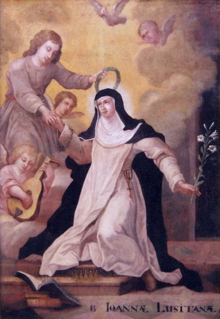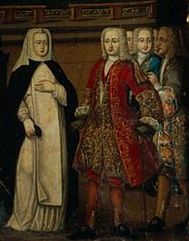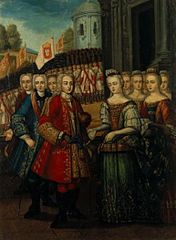| Joanna of Portugal | |
|---|---|
| Hereditary Princess of Portugal | |
 Portrait of Princess Saint Joana; 1471 Portrait of Princess Saint Joana; 1471 | |
| Born | 6 February 1452 Lisbon, Portugal |
| Died | 12 May 1490(1490-05-12) (aged 38) Aveiro, Portugal |
| Burial | Convent of Jesus in Aveiro |
| House | Aviz |
| Father | Afonso V of Portugal |
| Mother | Isabel of Coimbra |
| Religion | Catholicism |
| Blessed Joana de Portugal OP | |
|---|---|
 | |
| Venerated in | Roman Catholic Church |
| Beatified | 16 February 1692, Saint Peter's Basilica, Papal States by Pope Innocent XII |
| Feast | 12 May |
Joanna of Portugal OP (6 February 1452 – 12 May 1490; Portuguese: Joana, Portuguese pronunciation: [ˈsɐ̃tɐ ʒuˈɐnɐ pɾĩˈsezɐ]) was a Portuguese regent princess of the House of Aviz, daughter of King Afonso V of Portugal and his first wife Queen Isabel of Coimbra. She served as regent during the absence of her father in 1471. In 1475 she became a cloistered nun of the Dominican Order. She is venerated in the Catholic Church with the title 'Blessed', is commemorated by a feast on May 12th, and is commonly known in Portugal as Holy Princess Joan (Portuguese: Santa Joana Princesa).
Early life
Joanna was the second child of Afonso, but after the early death of her older brother John in 1451, she was recognized as heir presumptive and given the title of Princess of Portugal. Other children of the king were infantes. Upon the birth of her younger brother, the future John II of Portugal in 1455, she ceased to be heir presumptive, but among the people she continued to be known as Princess Joanna.
From a young age, Joanna expressed a desire to become a nun; however, as she was second-in-line to the throne, her father did not allow it.
During his military expedition to Tangier in 1471, Joanna served as Regent of the Portuguese Kingdom.
Marriage proposals
After vehemently refusing several proposals of marriage, Joanna joined the Dominican Convent of Jesus in Aveiro in 1475. Her brother had by then fathered an heir, so the family line was no longer in danger of extinction, and thus she entered the convent that same year her nephew Afonso was born in 1475. Still, she was compelled several times to leave the convent and return to court. She turned down an offer of marriage from Charles VIII of France, 18 years her junior. Her father abdicated in 1477, died in 1481, and was succeeded by her brother.
In 1485, she received another offer, from the recently widowed Richard III of England, who was only 8 months younger. This was to be part of a double marital alliance, with his niece Elizabeth of York marrying her cousin, the future Manuel I. However, his death in battle, of which Joanna allegedly had a prophetic dream, halted these plans.
Later life
She continued to be a great supporter of her brother, John II of Portugal, throughout his reign and her life.
Joanna died on 12 May 1490 in Aveiro and was buried in the Convent of Jesus in Aveiro. She bequeathed all her wealth to the convent. She was beatified in 1693 by Pope Innocent XII. In honor of her beatification, an official account of her life was issued in Italian. Although she has not been canonized, in Portugal she is known as the Princess Saint Joanna.
Revival
In the early 18th century, the Portuguese nobility, clergy, and court had a revival in interest in the princess. During this time, the Portuguese artist Manuel Ferreira e Sousa was the most famous artist in this revival. He was contracted by various religious institutions, noblemen, and even the royal family to paint scenes from her life.
Gallery
-
 Princess Saint Joanna with the Infant Jesus; by Joao Baptista Pachim, 18th century.
Princess Saint Joanna with the Infant Jesus; by Joao Baptista Pachim, 18th century.
-
 Engraving depicting the ‘saintly princess’ holding a skull, a crucifix, and a crown of thorns. Credit: Women of the Book Collection, Sheridan Libraries, Johns Hopkins University. Printed in Breve Narratione Della Vita della Beata Giovanna Principessa di Portogallo Dell’Ordine di San Domenico. Appellata communemente la Santa Principessa. Raccolta da un religioso Dell'istess' Ordine di Lei Devoto, Rome, 1693.
Engraving depicting the ‘saintly princess’ holding a skull, a crucifix, and a crown of thorns. Credit: Women of the Book Collection, Sheridan Libraries, Johns Hopkins University. Printed in Breve Narratione Della Vita della Beata Giovanna Principessa di Portogallo Dell’Ordine di San Domenico. Appellata communemente la Santa Principessa. Raccolta da un religioso Dell'istess' Ordine di Lei Devoto, Rome, 1693.





 Manuel Ferreira e Sousa's paintings of Princess Saint Joanna of Portugal were highly contracted from the 1720s to the 1740s.
Manuel Ferreira e Sousa's paintings of Princess Saint Joanna of Portugal were highly contracted from the 1720s to the 1740s.
Ancestry
| Ancestors of Joanna, Princess of Portugal | |||||||||||||||||||||||||||||||||||||||||||||||||||||||||||||||||||||||||||||||||||||||||||||||||||||||||||||||||||||||||||||||||||||||||||||||||||||||||||||||||||||||||||||||||||||||||||||||||||||||||||||||||||||||||||||||||||||||||||||||||||||||||||||||||||||||||||||||||||||||||
|---|---|---|---|---|---|---|---|---|---|---|---|---|---|---|---|---|---|---|---|---|---|---|---|---|---|---|---|---|---|---|---|---|---|---|---|---|---|---|---|---|---|---|---|---|---|---|---|---|---|---|---|---|---|---|---|---|---|---|---|---|---|---|---|---|---|---|---|---|---|---|---|---|---|---|---|---|---|---|---|---|---|---|---|---|---|---|---|---|---|---|---|---|---|---|---|---|---|---|---|---|---|---|---|---|---|---|---|---|---|---|---|---|---|---|---|---|---|---|---|---|---|---|---|---|---|---|---|---|---|---|---|---|---|---|---|---|---|---|---|---|---|---|---|---|---|---|---|---|---|---|---|---|---|---|---|---|---|---|---|---|---|---|---|---|---|---|---|---|---|---|---|---|---|---|---|---|---|---|---|---|---|---|---|---|---|---|---|---|---|---|---|---|---|---|---|---|---|---|---|---|---|---|---|---|---|---|---|---|---|---|---|---|---|---|---|---|---|---|---|---|---|---|---|---|---|---|---|---|---|---|---|---|---|---|---|---|---|---|---|---|---|---|---|---|---|---|---|---|---|---|---|---|---|---|---|---|---|---|---|---|---|---|---|---|---|---|---|---|---|---|---|---|---|---|---|---|---|---|---|---|---|
| |||||||||||||||||||||||||||||||||||||||||||||||||||||||||||||||||||||||||||||||||||||||||||||||||||||||||||||||||||||||||||||||||||||||||||||||||||||||||||||||||||||||||||||||||||||||||||||||||||||||||||||||||||||||||||||||||||||||||||||||||||||||||||||||||||||||||||||||||||||||||
Notes
- ^ McMurdo, Edward (1889). The history of Portugal, from the Commencement of the Monarchy to the Reign of Alfonso III. London: Sampson Low, Marston, Searle, & Rivington. p. 508. Retrieved 12 January 2024.
- ^ Capes, Florence. "Blessed Joanna of Portugal." The Catholic Encyclopedia. Vol. 8. New York: Robert Appleton Company, 1910. 25 Jul. 2014
- Breve Narratione della Vita della Beata Giovanna Principessa di Portogallo dellu Ordine di San Domenico. Rome: Nella Stamp. della R.C.A. . 1693.
Sources
![]() This article incorporates text from a publication now in the public domain: Herbermann, Charles, ed. (1913). "Bl. Joanna of Portugal". Catholic Encyclopedia. New York: Robert Appleton Company.
This article incorporates text from a publication now in the public domain: Herbermann, Charles, ed. (1913). "Bl. Joanna of Portugal". Catholic Encyclopedia. New York: Robert Appleton Company.
- Dominican Martyrology: May 12
- The Portuguese Princess's Dream, Richard III Society - American Branch Web Site. Richard III Society. Retrieved 2010-02-26.
External links
![]() Media related to Joan, Princess of Portugal at Wikimedia Commons
Media related to Joan, Princess of Portugal at Wikimedia Commons
| Joanna, Princess of Portugal House of AvizCadet branch of the House of BurgundyBorn: 6 February 1452 Died: 12 May 1490 | ||
| Preceded byFerdinand | Princess of Portugal 1452–1455 |
Succeeded byJohn (future John II) |
| Infantas of Portugal | |||||||||||||||||||||||||||||||||||||||||||||||
|---|---|---|---|---|---|---|---|---|---|---|---|---|---|---|---|---|---|---|---|---|---|---|---|---|---|---|---|---|---|---|---|---|---|---|---|---|---|---|---|---|---|---|---|---|---|---|---|
| The generations indicate descent form Afonso I, and continues through the House of Aviz, the House of Habsburg through Infanta Isabel, Holy Roman Empress and Queen of Spain, and the House of Braganza through Infanta Catarina, Duchess of Braganza. | |||||||||||||||||||||||||||||||||||||||||||||||
| |||||||||||||||||||||||||||||||||||||||||||||||
| * also an infanta of Spain and an archduchess of Austria, ** also an imperial princess of Brazil, *** also a princess of Saxe-Coburg and Gotha, Duchess in Saxony, ◙ Also a princess of Braganza, ƒ title of pretense | |||||||||||||||||||||||||||||||||||||||||||||||